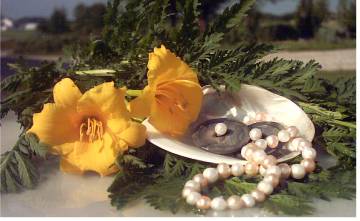|
How Pearls are Formed...Early TheoriesIt’s only natural that we wonder: How pearls are formed. Pearls--unique gems, not as hard as other gems, yet needing no cutting or polishing….true gifts of God—they arrive as finished products. How pearls are formed...Cultured ones, that is…read how here. Have you every wondered how fake black pearls are made? Or how faux graduated pearls are made? Here are some methods of making imitation pearls. (Click on photo for more pearl button jewelry photographs) The journey of human understanding about the mystery of pearls is intriguing...so I am including some of these early theories about how pearls are formed on this page. We live in an age of increased knowledge…let’s hope that an increase of wisdom to use that knowledge also is with us. Some of these theories of how pearls are formed will seem funny to us…”How could they be so stupid?”…but remember, we stand on the shoulders of others who have learned and sought out many truths. We often forget to appreciate their efforts. About the time of Christ, 2,000 years ago, some believed how pearls are formed was when a drop of dew which fell inside of an oyster as it came to the surface and opened its shells at the dawn of a sun shiny day. Still others thought a pearl was a gallstone in a sick oyster and that is how pearls are formed...oops...still not at the truth yet. Ancient Romans thought pearls were crystallized tears of angels. They must have thought the angels were crying a lot in Scotland. Did you know that it’s possibly because of the Scottish pearls that the Romans invaded Britain? The Greeks held to the theory that bolts of lighting piercing the sea caused pearls. I can just see these great minds sitting around, discussing this mystery. In the 1400’s Christopher Columbus thought that a drop of dew from Mangrove trees became a pearl after dropping into the sea. A Dutchman, Anselmus de Boot, in 1600, deducted that extra shell “fluid” developed into a pearl. How are pearls formed? Are we getting closer to the real truth? Yes, bit by bit, the mystery is revealed… Fransesco Redi, an Italian physician and naturalist, in 1671, claimed that if a grain of sand got into the shell, it caused a pearl to form. This is the most common explanation still used today…but it’s not quite a complete answer… In 1825, Sir Edward Hume, an Englishman, came up with this theory after cutting a pearl in half and finding a particle of egg-like lustrous material in the center. He thought a pearl resulted when an egg of the oyster died inside it. Louis Boutane, a French scientist, in 1904, said that is a parasite entered the oyster and settled in the “mantle” (the protective, cloak-like skin layer next to the oyster shell) and died there, then a portion of the mantle separated and a pearl formed around the parasite. Finally, it was a Japanese scientist, Tokichi Nishikowa, in 1907…not that long ago…who came to a clear understanding of the answer of the question: How are pearls formed? He understood that if a parasite enters an oyster and carries some nacre-secreting cells of the mantle with it and if that object becomes lodged in the oyster, the nacre-secreting cells or epithelial cells form a protective sac (pearl sac) over the object and by covering the object with nacre, a pearl is formed. Bingo! It took centuries and I’m sure much thought, investigation, discussion…but finally, the process is fully understood….which enables pearl farms to exist today and make lovely cultured pearls for the world to enjoy. We needn’t laugh at these early theories…this week I was in a jewelry store…and the clerks were also clueless about the question: How are pearls formed. You may enjoy learning more about pearls in history. So….how are pearls formed? We can be thankful that this mystery is solved for us….otherwise we’d need to be a queen to own pearls. Special thanks to Jo Mary McCormick, “Pearls in Pictures,” for these interesting facts on: How are pearls formed…early theories. Homepage for Karipearls
|







